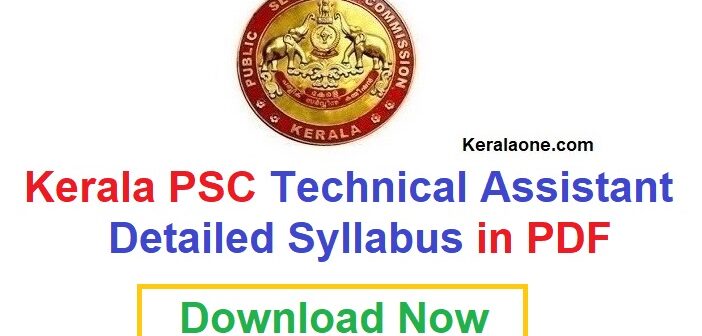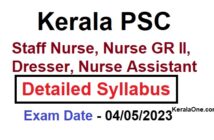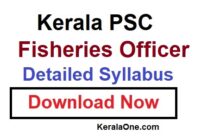Deprecated: Creation of dynamic property InsertPostAds::$settings is deprecated in /home4/keralaon/public_html/wp-content/plugins/insert-post-ads/insert-post-ads.php on line 427
Kerala PSC Technical Assistant Exam Syllabus – Cat. No. 087/2018
KPSC Technical Assistant Detailed Syllabus:- Candidates who are applied for the Technical Assistant vacancies in the department Kerala Agro Machinery Corporation Limited can find the detailed Syllabus for Technical Assistant exam 2020. Kerala PSC decided to conduct the Technical Assistant examination on the month of September 2020. To get a high score in the examination candidates need to go through the Technical Assistant syllabus thoroughly.
Kerala PSC KAMCO Vacancy Details
| Notification | Details |
|---|---|
| Post Name | Technical Assistant |
| Category Number | 087/2018 |
| Department | Kerala Agro Machinery Corporation Limited |
| Organisation | Kerala Public Service Commission |
| Official Website | https://www.keralapsc.gov.in/ |
| Exam Date | 15/09/2020 |
| Last Date to submit Confirmation | 10/02/2020 |
|
Notification
|
Motor Transport Sub Inspector Notification |
Kerala PSC Technical Assistant Detailed Syllabus
PART I MECHANICAL ENGINEERING
HYDRAULICS AND HYDRAULIC MACHINES
Properties of Fluid- Types of fluids-Ideal- Real- Newtonian and non newtonian – Fluid
pressure and its measurement- Fluid pressure at a point – pressure head – Pascal’s law –
absolute- gauge- atmospheric and vacuum pressures – measurement of fluid pressure –
Piezometer tube – simple manometer – differential manometer – inverted differential
manometer –Total pressure – total pressure on immersed surface- Buoyancy –buoyant
forces– Meta centre and meta centric height-– Rate of flow or discharge – equation of
continuity of liquid flow – Energy of a liquid in motion – potential energy- kinetic
energy- pressure energy- total energy- Total head of liquid in motion – Bernoulli’s
equation – assumptions – practical applications of Bernoulli’s equation – Flow through
Orifices- Notches- Pipes and Nozzles -Orifices – types of orifices – Vena contracta –
coefficient of contraction – coefficient of velocity – coefficient of discharge – Notches –
types of notches – loss of head in pipes – major energy losses – minor energy losses –
loss of energy due to friction – Darcy’s formula for loss of head in pipes – Chezy’s
formula for loss of head in pipes
Fluid Power– Applications of fluid power – properties of Hydraulic oils -Hydraulic
systems- Basic elements – Principles of working of Positive displacement pump –
Classifications – Gear pumps- Screw Pump- Vane pumps- Lobe pump. Hydraulic
actuators – Classifications – Rotary– Linear motion type – Hydraulic motors –Types of
Hydraulic cylinders – single acting- double acting – Hydraulic control elements and
components Control valves – Functions – classifications -Hydraulic symbols – Practical
applications of hydraulics
Impulse turbines-classification-impulse Turbine-Pelton wheel components – Reaction
turbines -components—difference between impulse& reaction—classification of reaction
turbines –discharge—power produced-work done—efficiencies—Francis turbine—
Kaplan turbine -draft tubes-types Centrifugal pump – types of casing—piping system of CP—work done- manometric head
—efficiencies –discharge –multistage pumps -specific speed of CP-cavitation—priming.–
performance curves of centrifugal pumps – comparison of CP & RP –discharge—sliphydraulic ram—air lift pump—jet pump.
Material handling, maintenance, Quality and safety
Definitions of quality- dimensions of quality- ISO 9000 & Installation -Concept and role
of ISO 9000, elements of ISO 9000, steps for installation of ISO 9000 – Quality Audit –
objectives list the objectives of quality planning Quality management system. TQM –
the link between ISO 9000 and TQM
Importance of safety in work place -increasing trends in industrial accidents -terminology
-factory accident -incident -severity rate — frequency rate -incidence rate -safety
performance index -accident proneness -unsafe acts list the causes of accidents: –
Mechanical, Environmental, personnel factors -accident prevention techniques – 4 E’S of
accident prevention technique . organizing safety -role of management -safety officers
-government norms -factories act of 1948 factories rule 1960 -emergency preparedness
and response -precautions to be observed in hazardous situations like toxic ,flammable
electrical shock and material handling
Plant location and layout- Factors to be considered in locating industrial plants – plant
layout – types of layouts – compare the advantages and disadvantages of each type –
factors influencing the plant layout . plant maintenance – types of maintenance –their
advantages and disadvantages-cost of maintenance – Material handling -functions and
principles of material handling – factors effecting material handlingtypes of material
handling equipments.
Strength of materials, design of machine elements
Types of stresses and strains – tensile and compressive – longitudinal and lateral strain
-Poisson’s ratio – stress strain diagram- ultimate stress – working stress – factor of safety
– Hooks law and Young’s modulus –principle of super position- stresses in varying
section -stresses in composite section – Shear stress and shear strain – modulus of rigidity
– volumetric strain- Young’s Modulus (E)- Bulk Modulus ( K) and Modulus of Rigidity
(C) relations.-Thermal Stress and strain – type of friction – static friction- dynamic
friction- sliding friction- rolling friction- limiting friction- angle of friction- coefficient of
friction- cone of friction – laws of friction. – Static friction and dynamic friction – force
analysis of a sliding body resting on a horizontal plane inclined plane –Centre of gravity
of section- Centroids – centre of gravity – axis of symmetry and axis of reference – CG of
simple geometric sections such as rectangle- triangle- circle and semicircle sections by
geometric consideration –Moment of inertia of sections – radius of gyration – methods to
find moment of inertia of plane area – parallel axis theorem-perpendicular axis theorem.
Types of beams – cantilever beam- simply supported beam- over hanging beam- built in
beam or fixed beam and continuous beam – types of loading – concentrated or point loaduniformly distributed load and uniformly varying load – shear force and bending moment
diagrams – cantilever beams – point load- uniformly distributed load and combination of
point load and uniformly distributed load – simply supported beam – point loaduniformly distributed load and combination of point load and uniformly distributed load –
maximum bending moment on the section.
Types of belts – flat belt, circular belt or rope, V-belt – types of flat belt drives — velocity
ratio – slip – creep – length of an open belt ,crossed belt – power transmitted by a belt
-ratio driving tensions for flat belt drive – angle of contact – centrifugal tension – V-belt
drive – rope or circular belt drive – chain drive – advantages and disadvantages over belt
drive.
Gears and Gear Trains- Functions of gears – friction wheels – advantages and
disadvantages of a gear drive – spur gear nomenclature – Velocity ratio – gear trains –
simple gear train – compound gear train – reverted gear train – epicyclic gear trainFunctions – classification of bearing- friction in journal bearing -design of thrust bearing
considering uniform pressure – flat pivot or foot step bearing-coefficient of friction and
bearing characteristic number – heat generated in journal bearings
Governors and Flywheels Functions of the governors – –terms in governors –Flywheels
Functions-comparison with governors – fluctuation of speed, energy, coefficient of
fluctuation of speed, energy-Energy stored in flywheels
Strength of solid and hollow shaft – comparisons -power transmitted by shaft – working
stresses for shafts -Compare solid and hollow shaft in terms of their weight, strength and
stiffness – Couplings-Shaft couplings – requirement – types -design of sleeve or muff
coupling – Designation and nomenclature of screw thread – stresses in screwed
fastenings due to static loading – initial stresses -stresses due to external forces –
Estimation of screw size – stresses due to combined forces – design of cylinder covers.
Material science – Manufacturing process
Metallic and non-metallic properties such as: – Mechanical, physical, and chemical
properties Mechanical properties:- strength, hardness, toughness, brittleness, creep,
fatigue, stiffness, ductility, malleability, elasticity and plasticity.-Physical properties: –
density, viscosity, color, finish, porosity, specific gravity, , fusibility- Thermal properties
Magnetic properties- Electrical Properties-Chemical properties: Destructive testing: –
tensile and compressive test-Hardness test: -Impact test, Fatigue test and Creep test- Non-
destructive testing: – Liquid Penetrant Test (LPT), Radiographic Test (RT), Ultrasonic
Testing(UT) -Stress- strain diagram for ductile and brittle materials.
Heat Treatment Processes-Alloys and Phase diagram- types of alloys-Solid solutionsInter metallic compounds- Mechanical mixture- cooling of alloy- Eutectic- EutectoidPeritectic- Peritectoid- Cooling Curve for Pure iron- -iron-carbon equilibrium diagramconstituents of steel from the iron-carbon equilibrium diagram- effect of slow cooling for
various composition- TTT diagram-heat treatment process- annealing normalizinghardening- tempering- martempering- austempering- case hardening (cyaniding- nitriding
and carbonizing)-residual stress due to heat treatment- age hardening
Orthogonal cutting and oblique cutting- chip formation -type of chips- cutting speed –
feed and depth of cut – tool signature/ nomenclature of the single point cutting toolproperties of various cutting tool materials- machinability- nomenclature of taper shank
Twist drill- plain milling cutters. Cutting tool material-lathe -drilling- milling- shaper.
Cutting fluids- Lubricants- coolants – requirement- properties- method of applicationselection.
Welding – classification of welding- advantages and limitation of welding. Arc welding –
Principle of arc welding- welded joints – butt- lap –corner– tee–edge – V- joints- U-jointsymbols as per BIS code. Welding electrodes-selection- Electrode coatings – functions of
Electrode coating. Gas welding – Oxy – Acetylene welding- Major advantages and
limitations – type of flames –functions and operation of oxy – acetylene cylindersDefects in welding – causes and remedies of the defects- joints- Soldering and brazing –
Comparison between welding- soldering and brazing
Measuring instruments- precision and non precision instruments- direct reading and
indirect measuring instruments- linear measuring instruments-angular measuring
instruments and plane surface measuring instruments- line measuring and end measuring
devices- Vernier caliper- micrometer (inside, outside, depth and vernier)- vernier height
gauge- vernier depth gauge.
PART II AUTOMOBILE ENGINEERING
AUTOMOBILE POWER PLANT (AUTOMOBILE)
Constructional details of engines: Cylinder block – Single cylinder and multi-cylinder,
materials, Water jackets – coolingfins, cylinder liners – wet type and dry type – materials.
Cylinder head – Materials,method of fixing the cylinder block, cylinder head gasket, combustion
chamber of petrolengines – expansion chambers Pistons – Trunk type pistons, composite pistons
– pistonmaterials expansion control in pistons – methods and types of piston -Piston rings –
Materials, method of manufacture, types of rings – compression ring, oil ring and special
purpose ring Gudgion pin – Types of fastening, material used Connecting rod – Function,
materials used big end and small end bearings Crank shaft – different shapes, different crank
shaft arrangements Main bearings, Fly wheel functions Types of valves – Poppet, reed valve and
disc valve, sodium vapour cooled valves, hydraulic tappet and free valve rotators
Different fuel feed systems, A.C. mechanical pump, S U Electrical pump ,petrol filters and air
Cleaners, Carburettors, Simple Carburettors – parts, principle of working, compensation, mixture
strength requirement, modern Carburettors, float system, idle and
slow speed system, high speed system, Acceleration pump and choke system.
Various components in Diesel fuel system – types of fuel injection – air injection and
mechanical injection, common rail and unit injection system. Types of combustion chamber in
Diesel engines – open, turbulent and pre-combustion chamber, etc Fuel injection – single
cylinder and multicylinder. Distributor type pump, rotary type pumps Fuel feed pump and hand
priming, diesel fuel filters. Governors – purpose, types – mechanical, pneumatic and hydraulic
governors
Lubrication system: – Properties of lubricating oil, different ratings of lubricating oil, types of
engine lubrication- wet and dry sump lubrication, splash and pressure feed systems. Oil pumps –
gear type, Vane type, plunger type and lobe type, pressure relief valve, oil pressure indicator Oil
coolers, oil filters, oil seals,Crank case ventilation – dilution Cooling system: – Air and water
cooling, thermo-syphon and pump circulation system over cooling, under cooling and optimum
cooling –
Introduction, Types of ignition system – battery coil & magneto – study of coil ignition,
Component study of ignition system – Ignition coil, Contact breaker points, Cam angle,
Condenser, Distributor, Sparkplug – types, Spark plug specifications, Spark advance & retard
mechanism (centrifugal & vacuum),Magneto ignition system – Rotating armature & rotating
magnet type, Polar inductor type. C.D. ignition system, Electronic ignition systems, Computer
controlled ignition. Distributor less ignition system.
AUTOMOBILE CHASSIS and TRANSMISSION (AUTOMOBILE)
Introduction – Various components required for a good transmission system.
Principle of friction clutches. Constructional features and working of-Single plate dry
clutch-Diaphragm clutch, Cone clutchCentrifugal clutch-Semi centrifugal clutch-Vacuum
clutch-Hydraulic clutch-Electromagnetic clutch-Overrunning clutches-Multi-plate clutch
(dry & wet)-Fluid fly wheel. Clutch disc – constructional details andfunctions of each
part, Pressure plate – constructional details and functions of each part. Clutch operating
mechanisms.
Introduction – Necessity and functions of a gearbox – constructional features &
working of – Sliding mesh gearbox-Constant mesh gearbox-Synchro mesh gearboxProgressive type gearbox – Epicyclic gearbox- Torque converter -Gear selector and
shifting mechanisms, 2 Wheeler transmissions-Gear drive, Chain drive-V-matic
transmission ,CVT& ECVT-Automatic transmission in cars.
Introduction of wheels & tyres-Wheels – wire – spoked wheel, disc wheel, and alloy
cast wheel,composite wheel-Wheel specification-Tyres-Tyre specification-Tyre
construction(cross sectional details).Tubeless tyre-Tyre treads patterns-Inflation pressure
and its effects (both over & under inflation)-Factors affecting tyre performance
Chassis -Introduction, Constructional details, Types of frame. Frame for 2 wheeler, 3
wheelers, and 4 wheeler, Testing of chassis -Front Axle- Introduction, Types– dead & live
axle, trans axles, Construction – material – cross section
Introduction to Suspension systems, Types of front suspension for Two, three & four
wheeler. Air suspension, Hydro-elastic suspension. Rear Suspension system,
Types-.Introduction to springs and Shockabsorbing devices, Types leaf coil, springs &
their arrangements, Helper spring, Spring shackle – shacklepin , Telescopic typeShock –
absorber, Hydraulic, gas filled type, Mono tube and Twin tube type, Basic
suspensionmovements pitching, bouncing, rolling etc.
Introduction to Steering system & steering geometry, Principles of steering,
Ackerman , Davis fifth wheel, Steering gear box – types, Worm & roller, worm & sector,
Re-circulating ball, Rack & pinion, Steeringlinkages – arrangement – components Power
steering – integral – linkage type, Collapsible type steeringcolumn. Wheel alignment –
Factors affecting wheel alignment.
Introduction to Brake Systems-, principle of operation, weight transfer principle, types
of brakes–mechanical, hydraulic, pneumatic, servo brake, Air brake – vacuum brake –
fail safe brake – dual brake –anti lock brake, Drum and disc brake system – Internal
expanding and externally contracting- Layout of brake system, mechanical Components,
hydraulic – master cylinder, types– working principle – wheel cylinder – brake bleeding,
brake shoe. Air brake – construction details – working – details components–servo brakes
-working of servo brake – types, vacuum and air – disc brake.
AUTOMOBILE SERVICE & MAINTENANCE (AUTOMOBILE)
Introduction to servicing and maintenance of Automobiles – various signs showing
the necessity of overhauling engine decarbonizing, vacuum test, compression test and
cylinder leakage teat. Causes of excessive lubricating oil consumption. Engine
dismantling and assembling. Checking of engine components – causes of cylinder wearcylinder re boring and honing – linear replacement. Servicing ofvalves. Value adjustment
and defects of valves. Piston defects and reconditioning methods.
Testing of connecting rods. Defects and reconditioning methods. Measurement of bearing
clearance andadjustment of connecting rod bearings. Crank shaft balancing and
machining processes
Servicing of petrol engine – defects in coil ignition system-Testing of ignition system
components. Setting of ignition timing-Checking of advancing units. Servicing of spark
plug. Trouble shooting of fuel system. Testing of A.C mechanical pump-Tuning of
carburettor- Engine tuning
Servicing of diesel engine – F.I. pump timing and bleeding of diesel fuel system. Testing
of Nozzles. Phasing and calibration of F.I. pump. Defects of F.I. pump and Nozzles.
Troubles and diagnosis in MPFI and CRDi systems.
Servicing of clutch assembly. Fitting of clutch, clutch adjustments. Removal and
refitting of trans-axle. Dismantling of propeller shaft and universal joint. Defects in
propeller shaft. Servicing of differential andrear axle. Removal of axles in full floating,
semi floating and three quarter floating types. Differentialtroubles and adjustments. Tube
repair. Causes of tyre wear. Tyre rotation, retreading and balancing of wheels.
PART III AGRICULTURAL ENGINEERING
Farm Power (Agricultural Engineering)
Sources of farm power – Renewable energy sources and uses farms –Engine power: terminology,
calculation and measurement – Power tiller: components, power transmission, clutch,
transmission gears, steering clutch / brakes, wheels, power transmission to implements – Tractor:
classification of tractors, leading manufacturers, tractor power transmission system, clutch and
its types, transmission gears, torque convertor, differential unit and final drive, tractor steering
system, braking system, tractor hydraulic system, tractor hitch, PTO, wheels and tyres
Farm Implements and Machinery (Agricultural Engineering)
Types of tillage – Types of tractor drawn implements – Methods of ploughing – Mouldboard
plough, its components, uses, adjustments – Disc plough, its components, uses, adjustments –
Harrows: types, components and uses – Cultivators: types, components and uses – Puddlers –
Bund formers – Rotovators – Sub-soiler – Seed drills: different types, components, seed metering
mechanisms, furrow openers, calibration of seed drills – Seed cum fertilizer drill: components,
metering mechanisms, furrow openers – Uses of power tillers on farms – Planters: components,
uses, different types – Paddy transplanters: types, working, components – Sprayers and dusters:
working principle, different types, basic components, type of spray, types of nozzles, types of
pumps for spraying, maintenance of sprayers and dusters – Uses and types of Mowers – Reapers:
types, components, working, uses – Threshers: types, basic components, working, uses, safety
precautions during operation, threshers for different crops – Combine harvesters: types, basic
components, working, uses, advantages and disadvantages – Functions and working principle of
chaff cutter, forage harvester, potato diggers, groundnut decorticators –Winnowers: types,
components, uses – Uses and types of cleaners and graders – Processing machinery for rice:
hullers, polishers, grinders – Pumps used on farms, construction and working of centrifugal
pumps
Download Detailed Syllabus in PDF
The below pdf file is the detailed syllabus for the Technical Assistant exam conducting Kerala psc. To download the Technical Assistant Syllabus in pdf file click on below.




